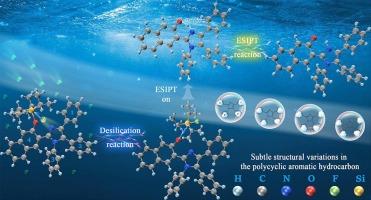Mechanistic insights into the influence of subtle structural variations on photophysical properties and desilication reaction
IF 4.6
2区 化学
Q1 SPECTROSCOPY
Spectrochimica Acta Part A: Molecular and Biomolecular Spectroscopy
Pub Date : 2025-09-09
DOI:10.1016/j.saa.2025.126922
引用次数: 0
Abstract
Fluoride ions (F−), an important trace element in the natural environment, and excessive intake may cause potential health risks. Fluorescent probes are always used for the detection of F−, and previous studies focused on modifying probes with various substituents to improve F− detection efficiency. However, most studies ignore the influence of the subtle differences in molecular structure on detection. Herein, we investigate the influence of the structural variations in polycyclic aromatic hydrocarbon (PAH) of 3-Hydroxy-2-naphthalene formaldehyde (HPNI) on the detection of F− by the DFT/TD-DFT methods. Our simulation results indicate that the subtle structural variations in PAH can regulate the energy barrier of the excited state intramolecular proton transfer (ESIPT) and photophysical properties, and the strength of hydrogen bonds is proved to be the main influencing factor for ESIPT. Moreover, based on the mechanistic analysis of the desilication reaction, a candidate probe is identified that exhibits superior F− detection performance compared to that reported in experimental studies. Our study will provide theoretical support for enhancing the sensitivity of F− detection and present a novel fluorescent probe with improved performance.

微观结构变化对光物理性质和脱硅反应影响的机理研究
氟离子(F−)是自然环境中重要的微量元素,过量摄入可能会造成潜在的健康风险。荧光探针一直被用于检测F−,以往的研究主要集中在用各种取代基修饰探针来提高F−的检测效率。然而,大多数研究忽略了分子结构的细微差异对检测的影响。本文研究了3-羟基-2-萘甲醛(HPNI)中多环芳烃(PAH)的结构变化对DFT/TD-DFT方法检测F−的影响。模拟结果表明,PAH结构的细微变化可以调节激发态分子内质子转移(ESIPT)的能量势垒和光物理性质,而氢键的强度是影响ESIPT的主要因素。此外,基于脱硅反应的机理分析,确定了一种候选探针,与实验研究相比,它具有更好的F−检测性能。我们的研究将为提高F−检测的灵敏度提供理论支持,并提出一种性能更好的新型荧光探针。
本文章由计算机程序翻译,如有差异,请以英文原文为准。
求助全文
约1分钟内获得全文
求助全文
来源期刊
CiteScore
8.40
自引率
11.40%
发文量
1364
审稿时长
40 days
期刊介绍:
Spectrochimica Acta, Part A: Molecular and Biomolecular Spectroscopy (SAA) is an interdisciplinary journal which spans from basic to applied aspects of optical spectroscopy in chemistry, medicine, biology, and materials science.
The journal publishes original scientific papers that feature high-quality spectroscopic data and analysis. From the broad range of optical spectroscopies, the emphasis is on electronic, vibrational or rotational spectra of molecules, rather than on spectroscopy based on magnetic moments.
Criteria for publication in SAA are novelty, uniqueness, and outstanding quality. Routine applications of spectroscopic techniques and computational methods are not appropriate.
Topics of particular interest of Spectrochimica Acta Part A include, but are not limited to:
Spectroscopy and dynamics of bioanalytical, biomedical, environmental, and atmospheric sciences,
Novel experimental techniques or instrumentation for molecular spectroscopy,
Novel theoretical and computational methods,
Novel applications in photochemistry and photobiology,
Novel interpretational approaches as well as advances in data analysis based on electronic or vibrational spectroscopy.

 求助内容:
求助内容: 应助结果提醒方式:
应助结果提醒方式:


